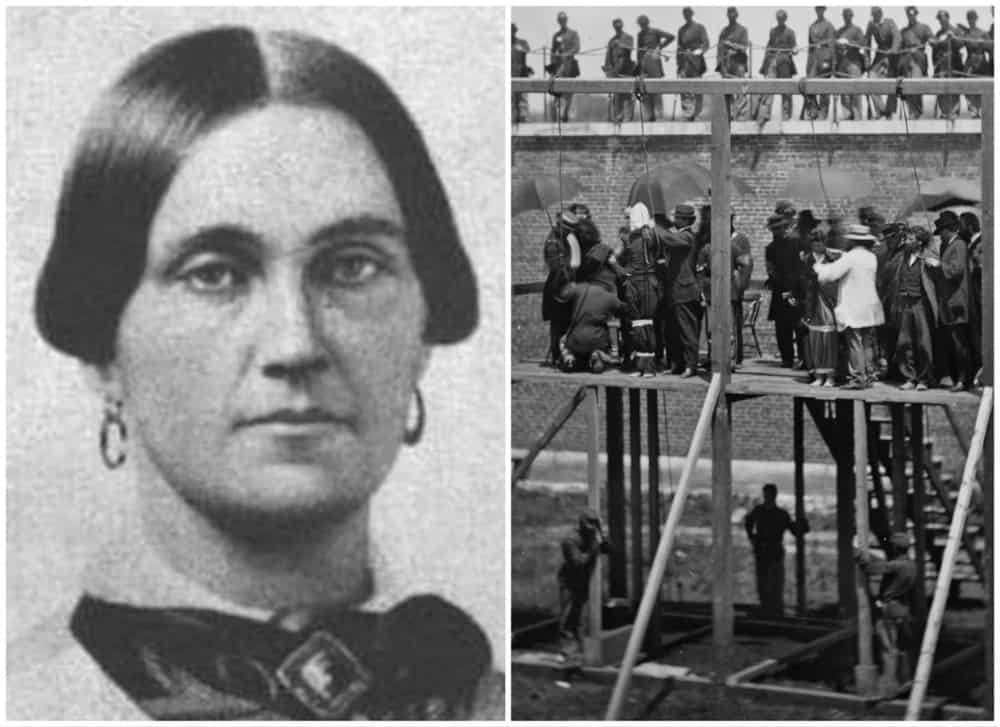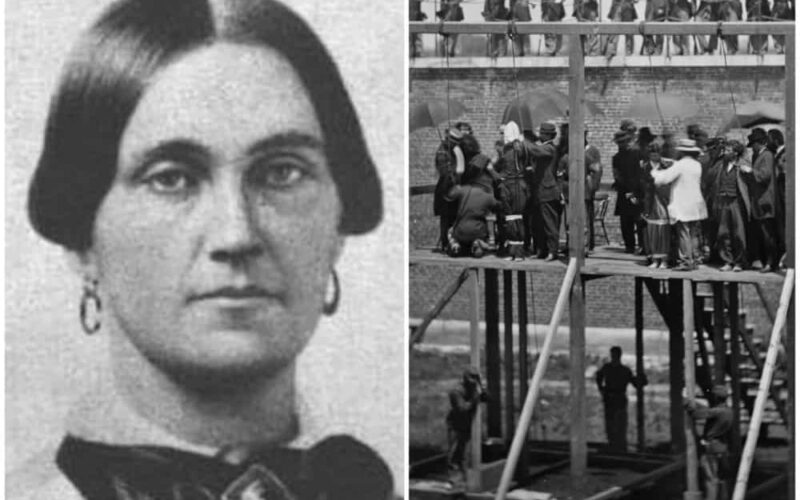Mary Surratt: The First Woman Executed by the U.S. Government

Mary Surratt holds a unique and somber place in American history as the first woman executed by the United States government. Her role in the conspiracy to assassinate President Abraham Lincoln has been the subject of debate and intrigue for over a century. Was she an active participant in the plot, or was she a victim of unfortunate circumstances?
In this article, we’ll explore the life of Mary Surratt, her involvement in one of the nation’s most infamous crimes, and the events that led to her controversial execution.
Early Life and Marriage
Mary Elizabeth Jenkins Surratt was born in 1820 in Waterloo, Maryland. She was raised in a Catholic family and received her education at a Catholic school, which was unusual for women at the time. In 1839, at the age of 19, Mary married John H. Surratt, a wealthy landowner from Washington, D.C. Together, they had three children: Isaac, Anna, and John Jr.
John Surratt’s business ventures included taverns, plantations, and a small post office in the town of Surrattsville, Maryland (present-day Clinton). The Surratts were well-known in their community and enjoyed a relatively comfortable life. However, John Surratt’s death in 1862 left Mary a widow, and the family struggled financially. In an attempt to make ends meet, Mary converted their home into a boarding house in Washington, D.C., which would later become infamous.
The Surratt Boarding House: A Hotbed for Conspiracy
Mary Surratt’s boarding house became a gathering place for various individuals who supported the Confederate cause during the Civil War. The house, located at 541 H Street in Washington, D.C., hosted a wide range of people, including Confederate sympathizers, spies, and political operatives. Among them was John Wilkes Booth, a famous actor and fervent Confederate sympathizer who would go on to assassinate President Lincoln.
Mary’s son, John Surratt Jr., played a crucial role in Booth’s circle of conspirators. As a Confederate courier and spy, John Jr. was involved in Booth’s initial plan to kidnap President Lincoln and use him as leverage to negotiate the release of Confederate prisoners. The kidnapping plot ultimately evolved into an assassination plot, and the Surratt boarding house became a key meeting point for the conspirators.
While Mary Surratt maintained that she was unaware of the plot, her boarding house’s reputation, combined with her son’s involvement, painted a different picture for investigators. Some witnesses claimed that she facilitated meetings between Booth and the other conspirators, while others alleged she actively aided their efforts.
The Assassination of President Lincoln
On April 14, 1865, John Wilkes Booth carried out his deadly plan, shooting President Lincoln at Ford’s Theatre. The assassination plunged the nation into mourning and set off a frantic manhunt for Booth and his co-conspirators. Authorities quickly apprehended several individuals connected to the plot, including Lewis Powell, David Herold, George Atzerodt, and Mary Surratt.
John Surratt Jr. managed to evade capture and fled the country, leaving his mother to face the consequences. Mary’s alleged involvement in the conspiracy placed her under intense scrutiny, and she was arrested on April 17, just days after the assassination.
The Trial of the Conspirators
Mary Surratt and her fellow conspirators were tried by a military commission rather than a civilian court. This decision, ordered by President Andrew Johnson, was controversial and led to questions about the fairness of the trial. The prosecution argued that Mary played an integral role in the conspiracy by providing material support to Booth and his associates, such as supplying firearms and offering her boarding house as a meeting place.
Several key pieces of evidence were presented against her. One of the most damning was the testimony of John Lloyd, the man who leased the Surratt tavern in Maryland. Lloyd testified that Mary instructed him to have “shooting irons” (weapons) ready for Booth and Herold on the night of the assassination. This testimony, combined with other circumstantial evidence, painted Mary as a willing participant in the conspiracy.
However, the defense argued that Mary was simply a devout Catholic widow who had been taken advantage of by her son and his associates. They contended that she had no knowledge of the assassination plot and was being unjustly persecuted due to her familial connections.
Controversy and Execution
Despite the defense’s arguments, the military commission found Mary Surratt guilty of conspiracy to assassinate President Lincoln. She was sentenced to death, along with Lewis Powell, David Herold, and George Atzerodt. On July 7, 1865, Mary Surratt was hanged, becoming the first woman in U.S. history to be executed by the federal government.
Her execution was not without controversy. Many, including her lawyers and supporters, petitioned President Andrew Johnson for clemency, arguing that her gender, lack of direct involvement, and questionable evidence should spare her from the gallows. However, President Johnson reportedly stated, “She kept the nest that hatched the egg,” implying that her role in providing a safe space for the conspirators was enough to justify the sentence.
Mary Surratt’s execution was met with a mix of shock and outrage. While some believed justice had been served, others saw her death as a tragic miscarriage of justice. The decision to hang a woman, especially one whose involvement was not as clear-cut as the others, left a lasting impact on the American legal system and public opinion.
Legacy and Debate
More than a century and a half later, the case of Mary Surratt continues to be a topic of debate among historians and legal scholars. Some view her as an innocent woman caught in the wrong place at the wrong time, while others argue that she played a more significant role in the assassination conspiracy than was initially believed.
In 2011, the film The Conspirator, directed by Robert Redford, reignited interest in Mary Surratt’s story. The movie portrayed her as a sympathetic character, wrongfully convicted and executed due to her association with the real conspirators. This cinematic portrayal renewed discussions about her guilt and whether the military tribunal that sentenced her acted within the bounds of justice.
A Tragic Figure in American History
Mary Surratt’s story is a tragic chapter in American history, one filled with unanswered questions and lingering doubts. Whether she was a key player in the plot to assassinate President Lincoln or an unwitting participant, her life and execution have left a lasting mark on the nation’s conscience. Her case serves as a stark reminder of the complexities of justice, the consequences of association, and the potential for error in times of national crisis.
Mary Surratt’s name will forever be linked with one of the darkest moments in U.S. history, and her execution remains a symbol of the harsh realities of justice during the turbulent aftermath of the Civil War.
FAQ About Mary Surratt
What happened to Mary Surratt?
Mary Surratt was arrested and charged with conspiracy in the assassination of President Abraham Lincoln. She was found guilty by a military tribunal and sentenced to death. On July 7, 1865, she was hanged, becoming the first woman executed by the U.S. government. Her case remains controversial, with debates surrounding her actual involvement in the assassination plot.
What was Mary Surratt’s role in Lincoln’s assassination?
Mary Surratt was accused of being part of the conspiracy to assassinate President Lincoln. She owned a boarding house in Washington, D.C., where several of the conspirators, including John Wilkes Booth, met to discuss their plans. Some witnesses claimed that she provided logistical support, including weapons, for the plot. However, her exact level of involvement has been debated, with some arguing she was unaware of the conspiracy.
What were Mary Surratt’s last words?
Mary Surratt’s exact last words are not clearly documented, but it is reported that as she stood on the scaffold before her execution, she simply said, “Please don’t let me fall.” These words reflected her fear of the impending hanging.
What was Mary Surratt’s trial like?
Mary Surratt was tried by a military commission, not a civilian court, which was a controversial decision. The trial lasted nearly two months, with the prosecution presenting testimony from witnesses like John Lloyd, who claimed that she provided weapons for the conspirators. Her defense argued that she was unaware of the assassination plot. Despite her claims of innocence, the tribunal found her guilty of conspiracy.
What was the cause of Mary Surratt’s death?
Mary Surratt was executed by hanging. She was sentenced to death by a military tribunal for her role in the conspiracy to assassinate President Lincoln. She was hanged on July 7, 1865, alongside three other conspirators.
How old was Mary Surratt when she died?
Mary Surratt was 42 years old when she was executed on July 7, 1865.
Are there any Mary Surratt descendants today?
Yes, Mary Surratt has descendants today through her children. Her son, John Surratt Jr., fled the country after the assassination but later returned and was tried for his involvement (though he was not convicted). He lived until 1916 and had children. Some of Mary Surratt’s descendants have publicly discussed their family history.
Is there a movie about Mary Surratt?
Yes, the film The Conspirator (2011), directed by Robert Redford, focuses on Mary Surratt’s trial and execution. The movie portrays her as a sympathetic figure caught in the aftermath of President Lincoln’s assassination and explores her defense attorney’s efforts to save her from execution.

